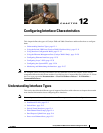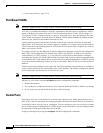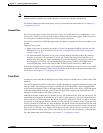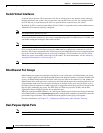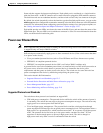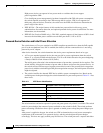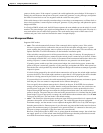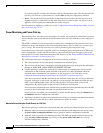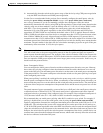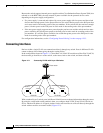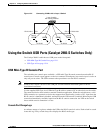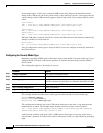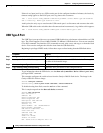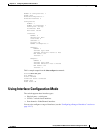
12-8
Catalyst 2960 and 2960-S Switch Software Configuration Guide
OL-8603-09
Chapter 12 Configuring Interface Characteristics
Understanding Interface Types
If you do not specify a wattage, the switch pre-allocates the maximum value. The switch powers the
port only if it discovers a powered device. Use the static setting on a high-priority interface.
• never—The switch disables powered-device detection and never powers the PoE port even if an
unpowered device is connected. Use this mode only when you want to make sure power is never
applied to a PoE-capable port, making the port a data-only port.
For information on configuring a PoE port, see the “Configuring a Power Management Mode on a PoE
Port” section on page 12-30.
Power Monitoring and Power Policing
When policing of the real-time power consumption is enabled, the switch takes action when a powered
device consumes more power than the maximum amount allocated, also referred to as the cutoff-power
value.
When PoE is enabled, the switch senses the real-time power consumption of the powered device and
monitors the power consumption of the connected powered device; this is called power monitoring or
power sensing. The switch also uses the power policing feature to police the power usage.
Power monitoring is backward-compatible with Cisco intelligent power management and CDP-based
power consumption. It works with these features to ensure that the PoE port can supply power to the
powered device. For more information about these PoE features, see the “Powered-Device Detection and
Initial Power Allocation” section on page 12-6.
The switch senses the power consumption of the connected device as follows:
1. The switch monitors the real-time power consumption on individual ports.
2. The switch records the power consumption, including peak power usage, and reports the information
through an SNMP MIB, CISCO-POWER-ETHERNET-EXT-MIB.
3. If power policing is enabled, the switch polices power usage by comparing the real-time power
consumption to the maximum power allocated to the device. For more information about the
maximum power consumption, also referred to as the cutoff power, on a PoE port, see the
“Maximum Power Allocation (Cutoff Power) on a PoE Port” section on page 12-8.
If the device uses more than the maximum power allocation on the port, the switch can either turn
off power to the port, or the switch can generate a syslog message and update the LEDs (the port
LED is now blinking amber) while still providing power to the device based on the switch
configuration. By default, power-usage policing is disabled on all PoE ports.
If error recovery from the PoE error-disabled state is enabled, the switch automatically takes the PoE
port out of the error-disabled state after the specified amount of time.
If error recovery is disabled, you can manually re-enable the PoE port by using the shutdown and
no shutdown interface configuration commands.
4. If policing is disabled, no action occurs when the powered device consumes more than the maximum
power allocation on the PoE port, which could adversely affect the switch.
Maximum Power Allocation (Cutoff Power) on a PoE Port
When power policing is enabled, the switch determines the cutoff power on the PoE port in this order:
1. Manually when you set the user-defined power level that the switch budgets for the port by using
the power inline consumption default wattage global or interface configuration command
2. Manually when you set the user-defined power level that limits the power allowed on the port by
using the power inline auto max max-wattage or the power inline static max max-wattage
interface configuration command




